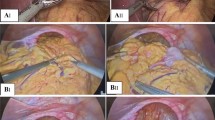Abstract
Background
Paraesophageal hernias (PEHs; types II-III-IV) account for about 5% of all hiatal hernias (HHs). The peculiarity of PEHs is the presence of a herniated sac which contains a more or less important part of the stomach, along with other abdominal organs in type IV PEHs. Surgical treatment is more complex since it requires a reduction not only of the herniated content but also of the “container,” namely the sac adherent to mediastinal structures. Since type III and IV PEHs are mostly grouped together as large PEHs, there is a lack of articles in the literature with regards to clear surgical outcomes, as well as management algorithms in type IV PEHs. This study aims to compare outcomes in type IV vs. type III PEHs after surgical repair.
Methods
A retrospective study of patients who underwent laparoscopic PEH hernia repair (LPEHR) was conducted in a single institution between 2006 and 2020. Patient baseline characteristics and surgical outcomes were analyzed.
Results
A total of 103 patients were included in the analysis. Patients presenting with type IV PEHs (12/103) were significantly older than patients with type III PEHs (91/104) (75.25 ± 7.15 vs. 66.91 ± 13.58 respectively (p = 0.039), and more fragile with a higher Charlson Comorbidity Index (CCI) (4.25 ± 1.48 vs. 2.96 ± 1.72, p = 0.016). Operative time was significantly longer (243 ± 101.73 vs. 133.38 ± 61.76, p = 0.002), and postoperative morbidity was significantly higher in type IV PEH repair (50% vs. 8.8% type III, p = 0.000).
Conclusion
Patients with type IV PEHs appear to be older and frailer. The higher incidence of postoperative complications in patients with type IV PEHs should advocate for a precise indication for surgical treatment, which should be performed in centers of expertise.


Similar content being viewed by others
References
Yu HX, Han CS, Xue JR, Han ZF, Xin H (2018) Esophageal hiatal hernia: risk, diagnosis and management. Expert Rev Gastroenterol Hepatol 12:319–329. https://doi.org/10.1080/17474124.2018.1441711
Skinner DBBR (1967) Surgical management of esophageal reflux and hiatus hernia. Long-term results with 1,030 patients. J Thorac Cardiovasc Surg. 53:33–54
El Lakis MA, Kaplan SJ, Hubka M, Mohiuddin K, Low DE (2017) The importance of age on short-term outcomes associated with repair of giant paraesophageal hernias. Ann Thorac Surg 103:1700–1709. https://doi.org/10.1016/j.athoracsur.2017.01.078
Hill LD (1973) Incarcerated paraesophageal hernia: A surgical emergency. Am J Surg 126:286–291. https://doi.org/10.1016/S0002-9610(73)80165-5
Polomsky M, Hu R, Sepesi B, O’Connor M, Qui X, Raymond DP, Litle VR, Jones CE, Watson TJ, Peters JH (2010) A population-based analysis of emergent vs. elective hospital admissions for an intrathoracic stomach. Surg Endosc 24:1250–1255. https://doi.org/10.1007/s00464-009-0755-1
Nijhuis RAO, van der Hoek M, Schuitenmaker JM, Schijven MP, Draaisma WA, Smout AJPM, Bredenoord AJ (2020) The natural course of giant paraesophageal hernia and long-term outcomes following conservative management. United Eur Gastroenterol J. https://doi.org/10.1177/2050640620953754
Dindo D, Demartines N, Clavien PA (2004) Classification of surgical complications: a new proposal with evaluation in a cohort of 6336 patients and results of a survey. Ann Surg 240:205–213. https://doi.org/10.1097/01.sla.0000133083.54934.ae
Dallemagne B, Kohnen L, Perretta S, Weerts J, Markiewicz S, Jehaes C (2011) Laparoscopic repair of paraesophageal hernia: Long-term follow-up reveals good clinical outcome despite high radiological recurrence rate. Ann Surg 253:291–296. https://doi.org/10.1097/SLA.0b013e3181ff44c0
Kohn GP, Price RR, Demeester SR, Zehetner J, Muensterer OJ, Awad Z, Mittal SK, Richardson WS, Stefanidis D, Fanelli RD (2013) Guidelines for the management of hiatal hernia. Surg Endosc 27:4409–4428. https://doi.org/10.1007/s00464-013-3173-3
Addo A, Sanford Z, Broda A, Zahiri HR, Park A (2020) Age-related outcomes in laparoscopic hiatal hernia repair: Is there a “too old” for antireflux surgery? Surg Endosc. https://doi.org/10.1007/s00464-020-07489-5
Brehant O, Pessaux P, Arnaud JP, Delattre JF, Meyer C, Baulieux J, Mosnier H (2006) Long-term outcome of laparoscopic antireflux surgery in the elderly. J Gastrointest Surg 10:439–444. https://doi.org/10.1016/j.gassur.2005.06.017
Jalilvand AD, Jones EL, Martin del Campo SE, Perry KA (2019) Octogenarians exhibit quality of life improvement but increased morbidity after paraesophageal hernia repair. Am J Surg. https://doi.org/10.1016/j.amjsurg.2019.09.014
Gangopadhyay N, Perrone JM, Soper NJ, Matthews BD, Eagon JC, Klingensmith ME, Frisella MM, Brunt LM (2006) Outcomes of laparoscopic paraesophageal hernia repair in elderly and high-risk patients. Surgery 140:491–499. https://doi.org/10.1016/j.surg.2006.07.001
Tam V, Luketich JD, Winger DG, Sarkaria IS, Levy RM, Christie NA, Awais O, Shende MR, Nason KS (2017) Non-elective paraesophageal hernia repair portends worse outcomes in comparable patients: a propensity-adjusted analysis. J Gastrointest Surg 21:137–145. https://doi.org/10.1007/s11605-016-3231-y
Jassim H, Seligman JT, Frelich M, Goldblatt M, Kastenmeier A, Wallace J, Zhao HS, Szabo A, Gould JC (2014) A population-based analysis of emergent versus elective paraesophageal hernia repair using the Nationwide Inpatient Sample. Surg Endosc 28:3473–3478. https://doi.org/10.1007/s00464-014-3626-3
Wirsching A, El Lakis MA, Mohiuddin K, Pozzi A, Hubka M, Low DE (2018) Acute vs. elective paraesophageal hernia repair: endoscopic gastric decompression allows semi-elective surgery in a majority of acute patients. J Gastrointest Surg 22:194–202. https://doi.org/10.1007/s11605-017-3495-x
Shea B, Boyan W, Decker J, Almagno V, Binenbaum S, Matharoo G, Squillaro A, Borao F (2019) Emergent repair of paraesophageal hernias and the argument for elective repair. J Soc Laparoendosc Surg. https://doi.org/10.4293/JSLS.2019.00015
Dara V, Croo A, Peirsman A, Pattyn P (2019) Necessity of fundoplication and mesh in the repair of the different types of paraesophageal hernia. Acta Gastroenterol Belg 82:251–256
Acknowledgements
The authors are grateful to Guy Temporal, professional in medical English proofreading for his valuable assistance with manuscript revision.
Funding
No funding was provided for this study.
Author information
Authors and Affiliations
Corresponding author
Ethics declarations
Disclosures
Jacques Marescaux is the President of IRCAD, who is partly funded by KARL STORZ and Medtronic. María Rita Rodríguez-Luna, Margherita Pizzicannella, Claudio Fiorillo, Abdullah Almuttawa, Alfonso Lapergola, Didier Mutter, Bernard Dallemagne, and Silvana Perretta have no conflicts of interest or financial ties to disclose.
Additional information
Publisher's Note
Springer Nature remains neutral with regard to jurisdictional claims in published maps and institutional affiliations.
Rights and permissions
About this article
Cite this article
Rodríguez-Luna, M.R., Pizzicannella, M., Fiorillo, C. et al. Impact of surgical repair on type IV paraesophageal hernias (PEHs). Surg Endosc 36, 5467–5475 (2022). https://doi.org/10.1007/s00464-021-08828-w
Received:
Accepted:
Published:
Issue Date:
DOI: https://doi.org/10.1007/s00464-021-08828-w




